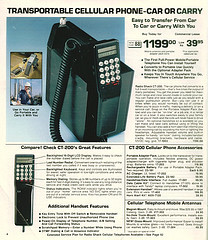Here’s Why Wireless Companies Are Going Gaga About Early Upgrade Programs

(SA_Steve)
In the last year, AT&T did away with early upgrades for customers, then announced AT&T Next, an early upgrade program. Verizon was the first to get rid of early upgrades, but its soon-to-be-announced Edge program is expected to encourage early upgrades. Meanwhile, T-Mobile recently showed off its JUMP early upgrade plan to allow subscribers to get new devices up to twice a year. Why all the sudden, and seemingly contradictory, focus on early upgrades?
OUT WITH THE OLD
As we mentioned when covering AT&T and Verizon’s decisions to do away with 20-month early upgrades for subscribers, wireless companies no longer need to sell consumers on the idea of the smartphone or of a data plan.
Six years ago, when the iPhone debuted, most of us had basic cellphones that maybe had a fuzzy camera and could download ringtones. Wireless companies wanted to get customers into more expensive smartphones with pricier monthly plans, so getting that upgrade at 20 months instead of 24 was an easy way to encourage the switch.
Android phones offered competition to the iPhone and the ensuing race to be the best, fastest, sleekest, thinnest, etc., led to a high rate of turnover in smartphones as early adopters sought to trade up for the newer, more improved device.
But now, smartphones are around 70% of the U.S. wireless market, and while innovations continue, not as many people are rushing to switch. The Wall Street Journal cites UBS analysts’ numbers in reporting that while 68 million people upgraded their phones last year, that number is down a whopping 9% from the year before and expected to keep dropping this year.
While upgrading your smartphone at 20 months may lock you in to your contract for another two years, you’re not really paying anymore for your plan (you might even be paying less if you realized you don’t use much data and downgraded your allotment), and the wireless company has plunked down (possibly significant) cash to subsidize your new phone.
That’s why the wireless carriers are ditching the old early upgrade model. So what’s with the new?
PAY NOW, UPGRADE LATER
The AT&T plan can be viewed as one of two things — either a way for the user to spread out the cost of a new device over 20 months, or a way for upgrade-happy users to keep trading up every 12 months. Regardless, either way is a win for AT&T.
The 20 monthly installments paid by the subscriber are for the unsubsidized cost of the phone. So if you’re buying a device with a $500 price tag and don’t use your upgrade ability after 12 months, AT&T is getting back the full amount in the end, along with 20 months of service payments.
If the subscriber does upgrade that phone after 12 months, AT&T will have received $300 of the full $500 sticker price for that phone and will lock that customer in for another 20-month plan. The customer has repaid 60% of the device’s full retail cost, which is much better than AT&T would do with the standard subsidized phone. For instance, a new Samsung Galaxy S4 will run you around $650 without a contract, but AT&T only charges around $150-$200 for this device to contract customers, which means the company is subsidizing a larger portion of that device’s cost.
T-Mobile already had a plan like this when it switched to its “un-carrier” model, that doesn’t lock users into the standard contract, but does retain them as customers through installment plans on their wireless devices.
So its JUMP plan goes a bit further, shortening the upgrade window to only 6 months. How can it do that? By charging a $10 monthly fee and by requiring a down-payment on your phone (and that you turn in your old phone in good condition when you upgrade).
Using the Galaxy S4 as an example again, T-Mobile currently requires a $150 down payment on the phone then $20/month for 24 months. JUMP subscribers would be paying $30/month when you factor in the program’s fee. So after 6 months — the earliest point at which the user can upgrade — he will have spent around $330, more than half the full cost of the phone. When he upgrades, he pays another down payment and starts anew with the monthly payments. Meanwhile, T-Mobile gets his old phone back and can sell it as a refurbished device and make additional money from it.
SO IS IT WORTH IT?
Unless you are a devoted early adopter who is constantly switching to the latest device, AT&T and T-Mobile’s new programs probably aren’t worth the cost.
The customer needs to decide whether that ability to possibly upgrade at 12 months is worth paying significantly more for her phone than she would have paid if she was willing to wait to use her scheduled upgrade.
And you should really only even consider these programs if you have every intention of upgrading at the earliest possible point. If an AT&T Next customer waits until 15 months to use his upgrade, he will have paid off 75% of that phone’s total cost; at 17 months it’s 85%. If a T-Mobile JUMP subscriber waits a year before upgrading her Galaxy S4, she will have paid off nearly 80% of its sticker price. At 15 months without an upgrade, she will have paid off more than 90% of the cost.
Every day you wait beyond that upgrade date puts more equity in the wireless company’s pocket, making the program worth less to you.
Want more consumer news? Visit our parent organization, Consumer Reports, for the latest on scams, recalls, and other consumer issues.

